Hey there, fellow digital nomads and travel aficionados! It’s your favourite Balkan Duo, Misho and Mile and today, we’re eager to share a personal story that shines a light on Split, Croatia, as a haven for people like us – those who love to blend work with wanderlust.
Our journey to Split was more than just a trip; it was a revelation of how a city can perfectly cater to the nomadic spirit.
Our adventure in Split began on a sunny afternoon, with laptops in our backpacks and a thirst for discovery in our hearts. We were immediately captivated by the city’s stunning blend of ancient architecture and modern flair.
It was in a quaint, sun-drenched café near Diocletian’s Palace where we first opened our laptops, the aroma of fresh coffee mingling with the sea breeze. Here, amidst the hum of local chatter and the clacking of our keyboards, we found a rhythm that was both productive and blissfully serene.
But it wasn’t just the work-friendly environment that made Split stand out. Each evening, as we stepped away from our screens, the city transformed into a playground for the senses. We wandered through the vibrant Riva promenade, mingled with locals and fellow travelers, and indulged in the rich flavors of Dalmatian cuisine. Split, with its unique blend of history, culture, and natural beauty, offered the perfect balance of work and play.
This personal experience in Split is what inspired us to create this digital nomad guide to Split. We realized that Split isn’t just a destination; it’s a lifestyle, one that resonates with anyone looking for a place that feels like both an office and a home away from home.
So, join us as we delve into the heart of this Adriatic gem, sharing insights and tips to make your stay in Split as memorable and productive as ours. Welcome to Split, a city that truly understands the digital nomad soul!
Cheers,
Misho and Mile
Reasons To Visit Split
Split is fast becoming a haven for digital nomads and travelers seeking a blend of ancient charm and modern convenience. Picture working from a cafe, your laptop open, with the Diocletian’s Palace as your backdrop – that’s Split for you.
The city’s rich history, evident in its old walls and winding streets, offers a unique workspace environment. Internet connectivity in Split is excellent, a crucial factor for nomads needing to stay connected.
Apart from work, Split provides a relaxed lifestyle, with its stunning beaches and vibrant markets. The food here is a culinary delight, especially for those who love seafood. And let’s not forget the local wines – perfect for unwinding after a day’s work.
For digital nomads and travelers looking for a blend of work and leisure, Split offers an unparalleled experience where history and modernity coexist beautifully.
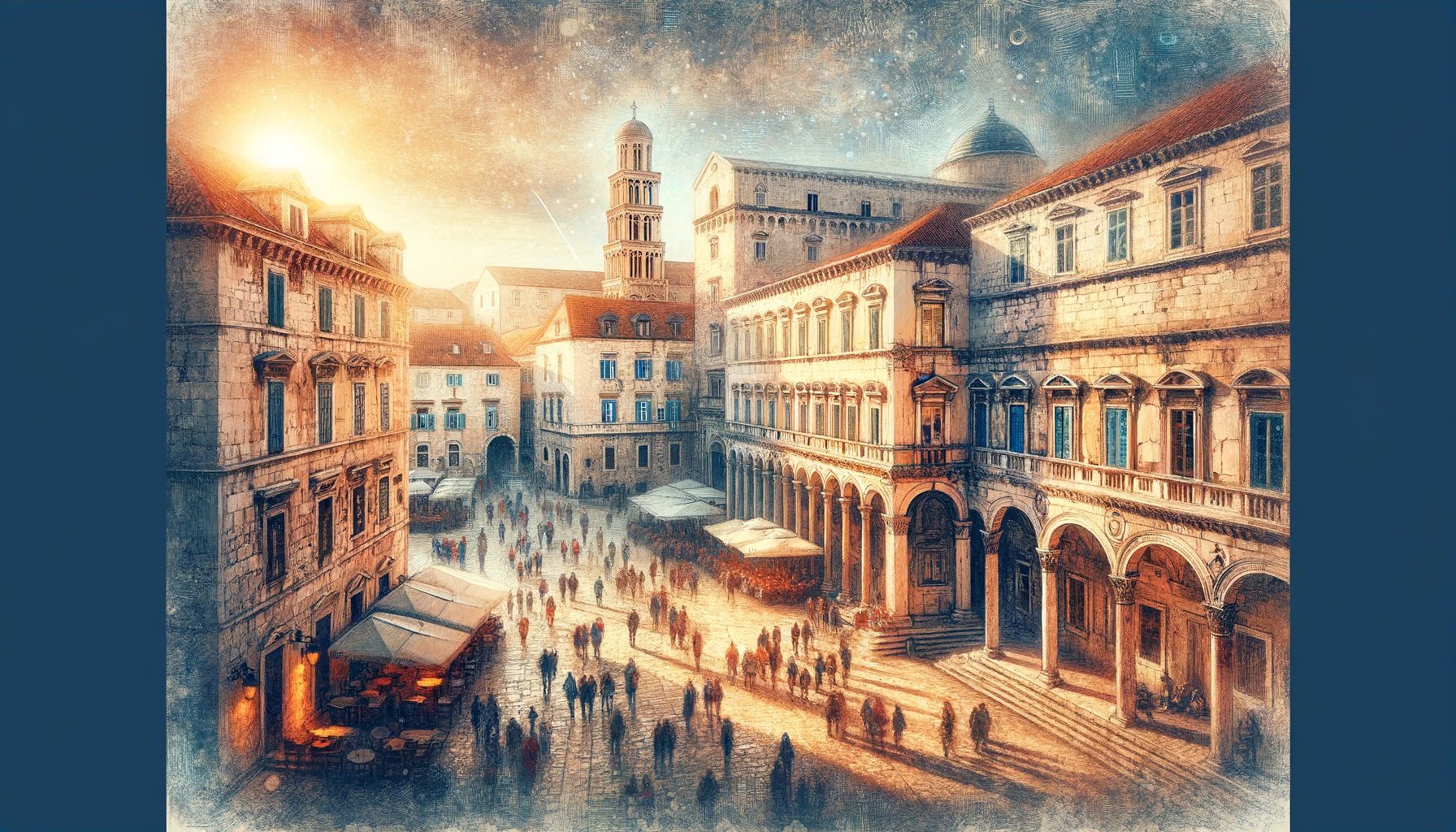
Where Is Split
Split is situated in the heart of the Dalmatian Coast in Croatia. It lies on the eastern shore of the Adriatic Sea. Geographically, it’s strategically positioned, acting as a gateway to the numerous islands dotting the Adriatic, such as Hvar, Brač, and Vis. This prime location offers breathtaking views of both the sea and the surrounding rugged coastal mountains.
The city is easily accessible, with Split Airport serving as a convenient entry point for international travelers. It’s also well-connected by road and sea, making travel to and from other Croatian destinations and neighboring countries seamless.
The Adriatic highway, a scenic route running along the coast, brings travelers directly to Split, offering an unforgettable journey with spectacular seaside vistas.
Connectivity and Workspaces in Split
Split, while steeped in ancient history, is surprisingly modern when it comes to connectivity and workspaces, making it an ideal spot for digital nomads. The city boasts a robust and reliable internet infrastructure, essential for those needing a steady online presence. Numerous cafes and public spaces offer free Wi-Fi, allowing you to work with a view of the Adriatic or the bustling city life.
For a more structured environment, Split has seen a growth in coworking spaces. although we only visited two, the WIP Coworking and Saltwater Workspace, we were surprised, because not only do they provide a desk and internet, but also a community of like-minded professionals. They’re perfect for networking, collaborating, or just enjoying a change of scenery from the usual cafe backdrop.
Even better, many of these workspaces are located in the city center, meaning you’re never too far from a historic site or a beach, blending work and leisure seamlessly.
Wi-Fi and internet speed in Split
The city is equipped with widespread Wi-Fi access, especially in central areas like the Riva waterfront and the Diocletian’s Palace vicinity. Cafes, restaurants, and public spaces frequently provide free Wi-Fi to customers, making it easy to stay connected while enjoying the local ambiance.
Best co-working spaces in Split
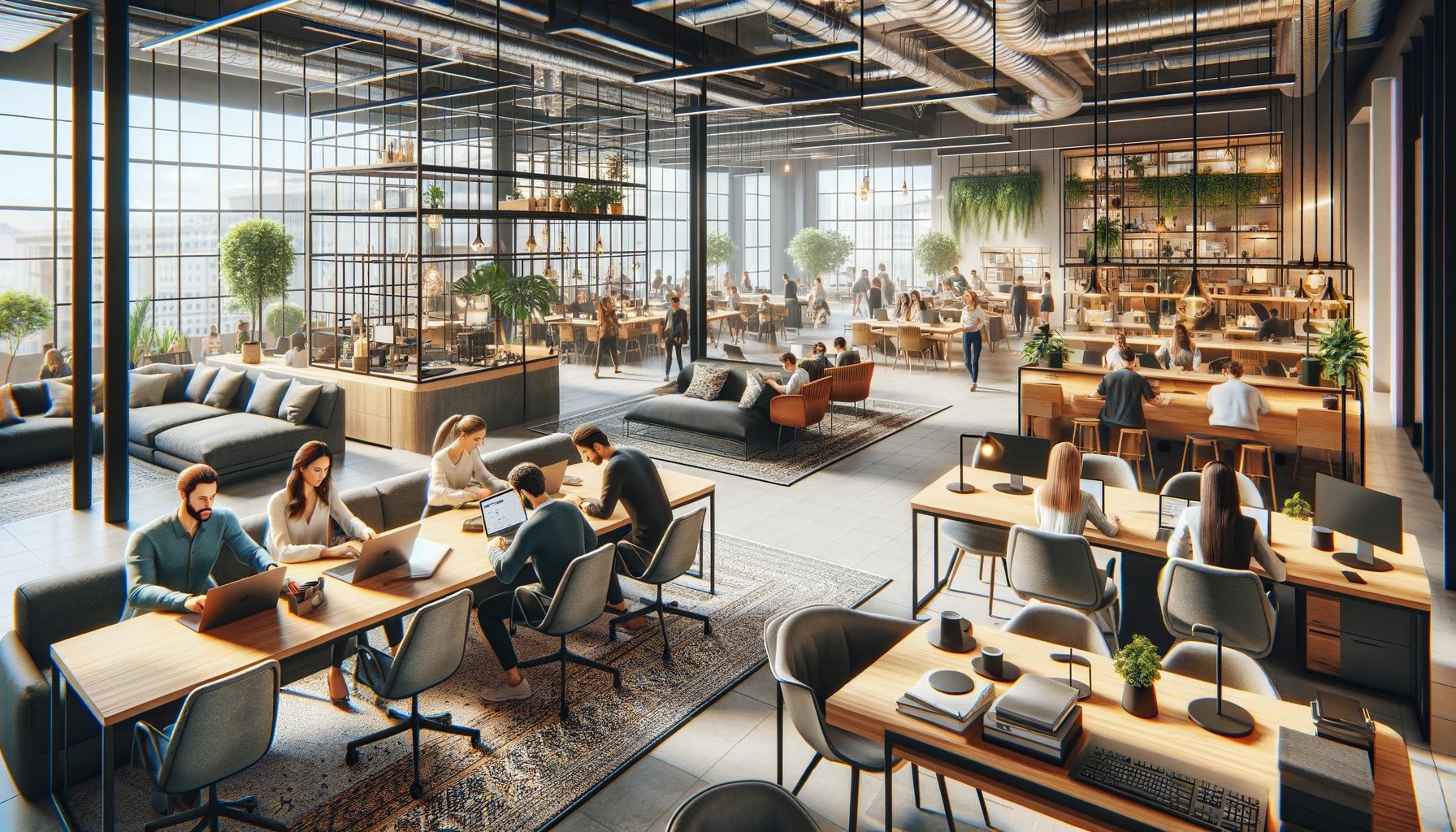
Here are the two coworking spaces we visited in Split:
- WIP Coworking: Located in the city center, WIP offers a stylish and comfortable working environment. It’s known for its vibrant community, hosting regular events and meetups.
- Saltwater Workspace: Overlooking the Adriatic Sea, Saltwater provides a serene setting ideal for creativity and productivity. It’s perfect for those who love a view while they work.
Best Cafes and public spaces with Wi-Fi access in Split
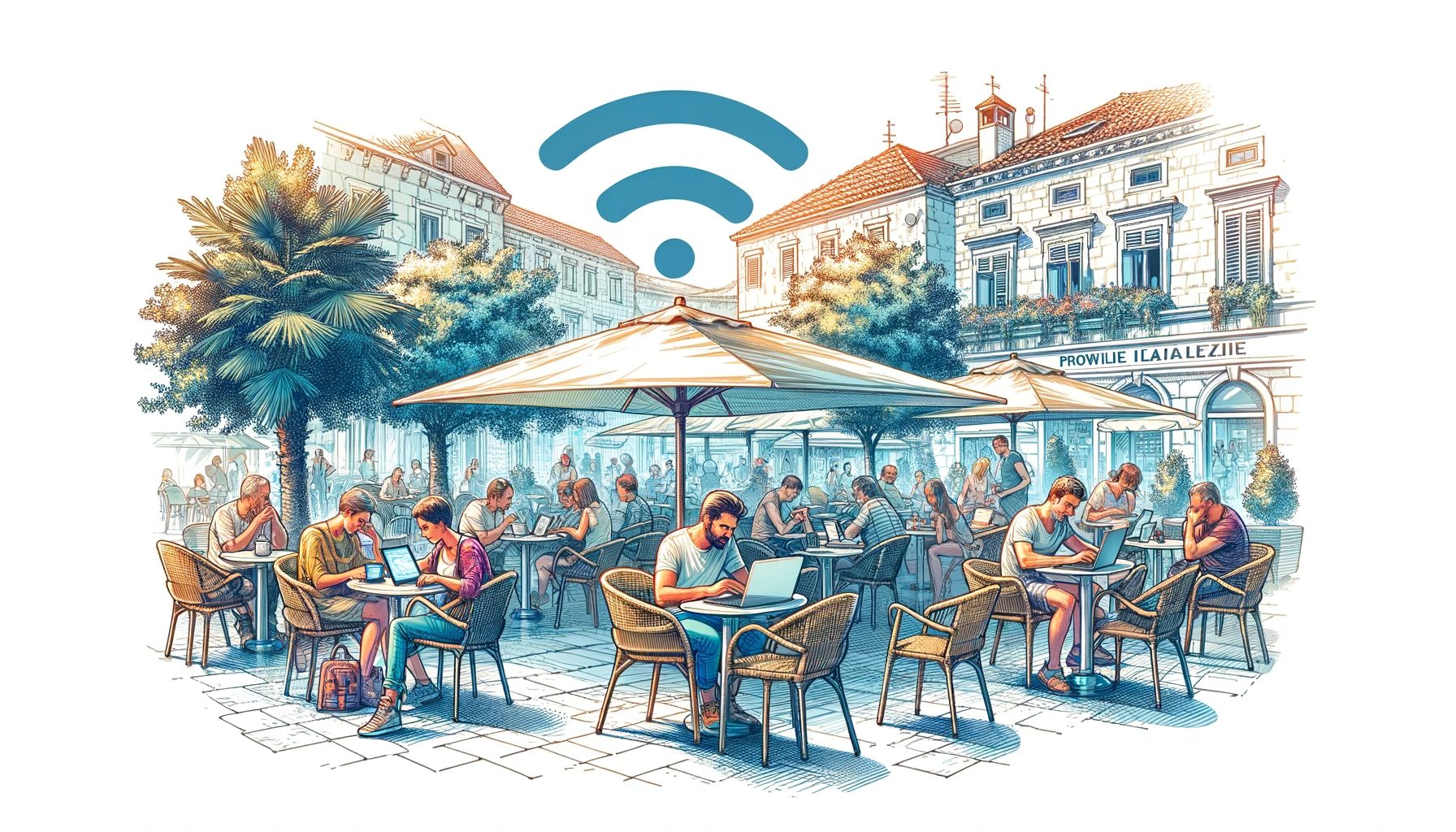
Here are some cafes and public spaces known for their coffee and laidback vibes:
- D16 Coffee: A favorite among locals and tourists alike, located in the heart of the Diocletian’s Palace area. Known for its excellent coffee and reliable Wi-Fi.
- 4Coffee Soul Food: Situated near the Riva, this cozy cafe offers a peaceful environment for work or relaxation, with good Wi-Fi connectivity.
- Cafe Bar Fro: Located on the Marjan hill, it’s a perfect spot for those looking for a scenic view along with their coffee and internet access.
- Lvxor Kavana & Restoran: Set in the Peristyle of Diocletian’s Palace, this cafe provides a unique backdrop for your remote work sessions, complete with dependable Wi-Fi.
- St.Riva: Split’s famous waterfront promenade, lined with various cafes and seating areas, where you can access free public Wi-Fi while enjoying the bustling atmosphere.
- Josip Juraj Strossmayer Park (Đardin): A popular public park offering a green escape within the city. Here, you can find Wi-Fi access, perfect for working outdoors on sunny days.
These spots not only offer reliable internet access but also a taste of Split’s local life and culture. Whether you’re looking for a quiet corner to focus or a lively spot to draw inspiration from, you’ll find a place that suits your needs in Split.
Short-term rentals and apartments in Split

Split offers a wide range of short-term rental and apartment options, perfect for travelers seeking a home-away-from-home experience. Here are some notable choices:
- Riva Luxury Suites: Located right on the famous Riva Promenade, these suites offer stunning views and modern amenities, ideal for those wanting to be in the heart of the city.
- Divota Apartment Hotel: Situated in the charming Veli Varoš neighborhood, Divota offers stylish apartments with a blend of traditional and contemporary design, perfect for a comfortable stay.
- Banica Apartments & Rooms: Nestled near the Diocletian’s Palace, Banica provides a mix of modern and rustic charm, with easy access to the city’s major attractions.
- Balatura Split Luxury Rooms: Offering elegantly designed rooms and apartments in the center of Split, Balatura is known for its luxurious feel and close proximity to historic sites.
- Priska Luxury Rooms: Located a bit away from the city’s hustle, Priska offers serene and spacious accommodation, ideal for those looking for a peaceful retreat.
- Apartments Gajeta: Centrally located and family-run, Apartments Gajeta are well-furnished and offer a cozy stay, close to all major attractions.
- Boban Luxury Suites: Offering a bit of luxury with a rooftop pool and stylish apartments, it’s a great choice for travelers looking for comfort and elegance.
Each of these options provides a unique experience, blending the convenience of city living with the comforts of home. Whether you’re staying for a few days or a few weeks, you’ll find an array of choices to suit your preferences in Split.
Hostels and budget-friendly options in Split
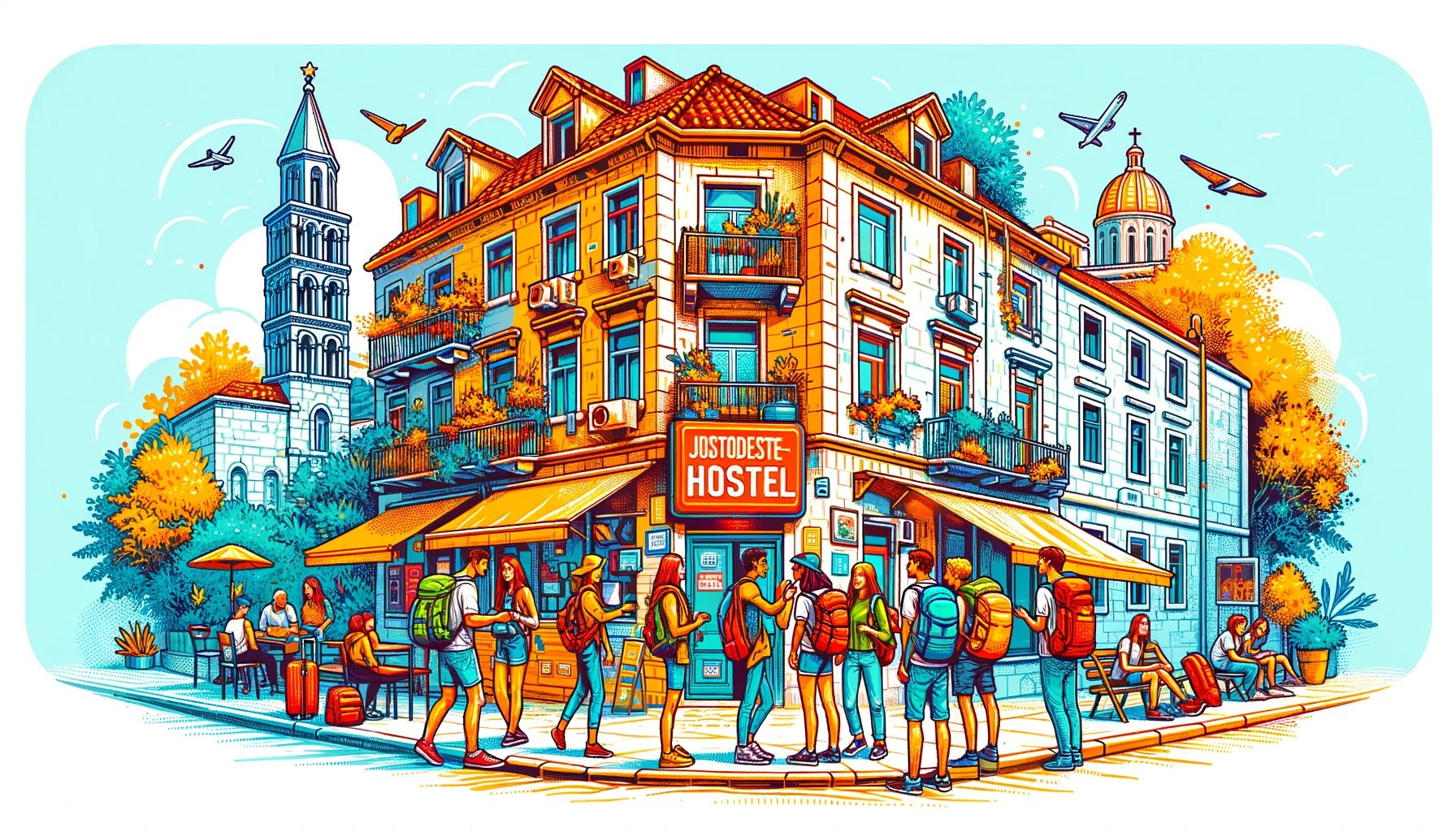
Hotels and luxury accommodations in Split

Split, catering to travelers who prefer luxury and comfort, offers a range of high-end hotels and upscale accommodations. Here’s a list of some of the top luxury stays in the city:
- Le Méridien Lav Split: This five-star hotel is a symbol of luxury, offering stunning sea views, a private beach, world-class dining, and a state-of-the-art spa.
- Radisson Blu Resort & Spa: Located along the scenic Adriatic coast, this resort provides luxurious rooms, an expansive spa, and dining options with breathtaking views.
- Hotel Park Split: A historic hotel that combines traditional charm with modern luxury, Hotel Park is known for its elegant rooms, fine dining restaurant, and prime location near Bačvice Beach.
- Cornaro Hotel: Situated in the heart of the city, Cornaro offers upscale comfort with its contemporary rooms and suites, rooftop terrace, and excellent service.
- Hotel Vestibul Palace: Nestled in the walls of Diocletian’s Palace, this boutique hotel blends ancient architecture with modern luxury, creating a unique and upscale experience.
- Hotel Atrium: A contemporary five-star hotel, offering spacious rooms, a wellness center, and a location convenient for exploring both the old town and modern Split.
- Hotel Luxe: A boutique hotel known for its sleek design and panoramic views of the city and sea. It provides a blend of luxury and convenience, with easy access to Split’s main attractions.
Each of these hotels offers a distinct experience, whether you’re looking for historical charm, beachfront luxury, or modern elegance. With top-notch amenities and exceptional service, they ensure a stay in Split is as comfortable as it is memorable.
Cost of Living in Split
The cost of living in Split, Croatia, is generally more affordable compared to many Western European cities, though it can vary based on lifestyle and choices. Here’s a breakdown of the average costs:
- Housing: Rent is one of the largest expenses. A one-bedroom apartment in the city center can cost around €400-€600 per month, while outside the center, the price drops to about €300-€500.
- Utilities: Monthly utilities for an average apartment (including electricity, heating, water, and garbage) typically range between €100 and €150. Internet costs about €20-€30 per month.
- Groceries: For a single person, average monthly grocery expenses are approximately €150-€200, depending on eating habits and preference for local or imported products.
- Eating Out: A meal at an inexpensive restaurant can cost around €7-€12, while a three-course meal at a mid-range restaurant might be around €20-€30 per person.
- Transportation: Public transport is affordable, with a monthly pass costing about €40. Taxis and ride-hailing services like Uber are also available, with average fares.
- Leisure Activities: Leisure costs will depend on personal preferences. Movie tickets are about €4-€6, and a gym membership can range from €20 to €40 per month.
- Healthcare: While public healthcare is available, many opt for private health insurance, which can vary in cost.
Overall, Split offers a relatively cost-effective lifestyle, especially when considering its location along the beautiful Dalmatian coast, providing a high quality of life for its residents. This affordability combined with the city’s rich culture and natural beauty makes it an attractive destination for expats and digital nomads. Next, let’s explore the healthcare and emergency services available in Split.
Comparison to other European destinations with Split
Comparing Split, Croatia, to other European destinations offers an interesting perspective on what makes this Adriatic city stand out.
1. Split vs. Barcelona, Spain: Both cities boast a vibrant mix of history and modernity. While Barcelona is renowned for Gaudi’s architecture and a larger urban sprawl, Split offers a more intimate experience with the Diocletian’s Palace and its Roman heritage. Split tends to be more affordable than Barcelona, with a more laid-back Mediterranean lifestyle.
2. Split vs. Nice, France: Nice, like Split, sits on the coast and offers stunning sea views. However, Split’s historical significance, especially with its well-preserved ancient Roman architecture, provides a more historic ambiance. Cost-wise, Split is generally more budget-friendly than Nice, which is known for its luxury and higher living costs.
3. Split vs. Venice, Italy: Both cities are rich in history and culture, but Split offers a unique blend of Roman and Mediterranean influences, unlike Venice’s Gothic and Renaissance architecture. Split is less tourist-heavy and more affordable, offering a quieter but equally enriching experience.
4. Split vs. Athens, Greece: Athens shares a similar ancient vibe with its ruins and historical sites. However, Split’s seaside location and smaller size offer a different atmosphere, focusing on leisurely exploration and beach activities. In terms of costs, both cities are comparable, providing good value for travelers.
5. Split vs. Dubrovnik, Croatia: Both Croatian cities offer stunning coastal views and rich histories. Dubrovnik, famous for its medieval walls and Game of Thrones fame, is generally more crowded and expensive than Split, which offers a more relaxed and authentic Dalmatian experience.
In summary, Split stands out for its unique blend of ancient history, relaxed Mediterranean lifestyle, affordability, and less crowded environment compared to other popular European destinations. Now, let’s explore the best day trips and excursions you can enjoy from Split.
Split Vs. Chiang Mai
Comparing Split, Croatia with another city for digital nomads involves considering factors like cost of living, internet connectivity, community of digital nomads, quality of life, and cultural offerings. A city that shares the most similarities with Split in these aspects is Chiang Mai, Thailand.
- Cost of Living: Both Split and Chiang Mai are known for their relatively affordable cost of living compared to major Western cities. This is a crucial factor for digital nomads who often prioritize budget-friendly destinations.
- Internet Connectivity: High-speed internet is essential for digital nomads. Split, like Chiang Mai, offers reliable internet services, which is a fundamental requirement for remote work.
- Nomad Community: Both cities host a vibrant community of digital nomads. This community provides networking opportunities, socializing, and professional collaborations.
- Quality of Life: Split and Chiang Mai both offer a good quality of life with access to natural beauty, recreational activities, and a generally relaxed lifestyle. These factors are often sought after by digital nomads who value work-life balance.
- Cultural and Historical Significance: Both cities are rich in culture and history. Split is known for its Roman architecture and Mediterranean ambiance, while Chiang Mai is celebrated for its ancient temples and rich Thai culture.
- Climate: While different in terms of weather, both cities offer a pleasant climate for most of the year. Split has a Mediterranean climate with hot, dry summers and mild winters. Chiang Mai, in contrast, has a tropical climate, which is warm throughout the year.
- Language: English is widely spoken in both cities among the younger population and the nomad community, making it easier for international nomads to adapt.
However, there are differences too, such as the cuisine, the specific cultural nuances, and the overall vibe of each city. While Split offers a European coastal city experience, Chiang Mai provides a unique blend of traditional Thai culture and modern amenities.
Average costs for food, transportation, and leisure activities in Split
Split, Croatia, offers a range of options for food, transportation, and leisure activities, catering to various budgets. Here’s an overview of the average costs:
Food:
- Groceries: For a week’s worth of groceries, including local produce, expect to spend around €50 to €70, depending on your diet and preferences.
- Eating Out: A meal at an inexpensive restaurant can cost about €10 to €15 per person. A three-course meal at a mid-range restaurant might be around €25 to €35 per person. Seafood and finer dining will be higher.
Transportation:
- Public Transport: A single bus or ferry ticket in Split costs approximately €1.50 to €2.50. Monthly passes, ideal for longer stays, are around €30 to €40.
- Taxis: Starting rates are about €3, with an average cost of €1 per kilometer.
- Car Rental: Prices start from around €30 per day for a basic car, increasing for larger or luxury vehicles.
Leisure Activities:
- Beach Activities: Many beaches are free to access, though renting a sunbed or umbrella can cost around €10 to €20 per day.
- Museum and Historical Sites: Entry fees range from €5 to €10. The Diocletian’s Palace, a must-visit, has parts that are free to explore, with specific sections like the cellar having an entry fee of around €7.
- Day Trips and Tours: Prices vary widely, with local island tours starting around €40 to €60, and more extensive excursions costing upwards of €100.
Keep in mind that these are average costs and can vary based on the season and personal choices. Split offers a range of options, from budget-friendly to luxury experiences, making it accessible for a wide range of travelers.
9 Tips for budget-conscious nomads when visiting Split
Visiting Split, Croatia, can be a delight for budget-conscious nomads if you know the right tips and tricks. Here are some valuable insights to help you enjoy the city without straining your wallet:
- Accommodation: Consider staying in hostels, guesthouses, or budget hotels. Booking in advance or during the off-peak season can also snag you better deals. Alternatively, look for shared apartments or rooms on platforms like Airbnb.
- Eating Out: Eat like a local. Avoid tourist traps and dine at smaller, local restaurants known as ‘konoba’ where you can enjoy authentic Croatian dishes at lower prices. Street food and bakeries also offer affordable and delicious options.
- Public Transport: Utilize Split’s efficient public transport system, which is cheaper than taxis. Consider walking to nearby attractions – Split is pedestrian-friendly, and walking is a great way to soak in the city’s atmosphere.
- Free Attractions: Explore free attractions like the Riva Promenade, Marjan Hill, and the exterior of the Diocletian’s Palace. Many of Split’s charming neighborhoods and markets don’t cost a thing to enjoy.
- Discounts on Activities: Look for discounts on tours and activities. Sometimes, group tours offer lower rates, or you can find online deals before your visit.
- Groceries and Cooking: If your accommodation has kitchen facilities, consider cooking some meals. Local markets offer fresh, affordable produce.
- Local SIM Card: Get a local SIM card for mobile data instead of relying on international plans, which are often more expensive.
- Happy Hours and Special Deals: Keep an eye out for happy hours at bars and special meal deals at restaurants, which can save you money on dining out.
- Cultural Events: Check out local cultural events or festivals. Many of these are free or have a low entry cost and are a great way to experience local life.
12 best things to do in and around Split
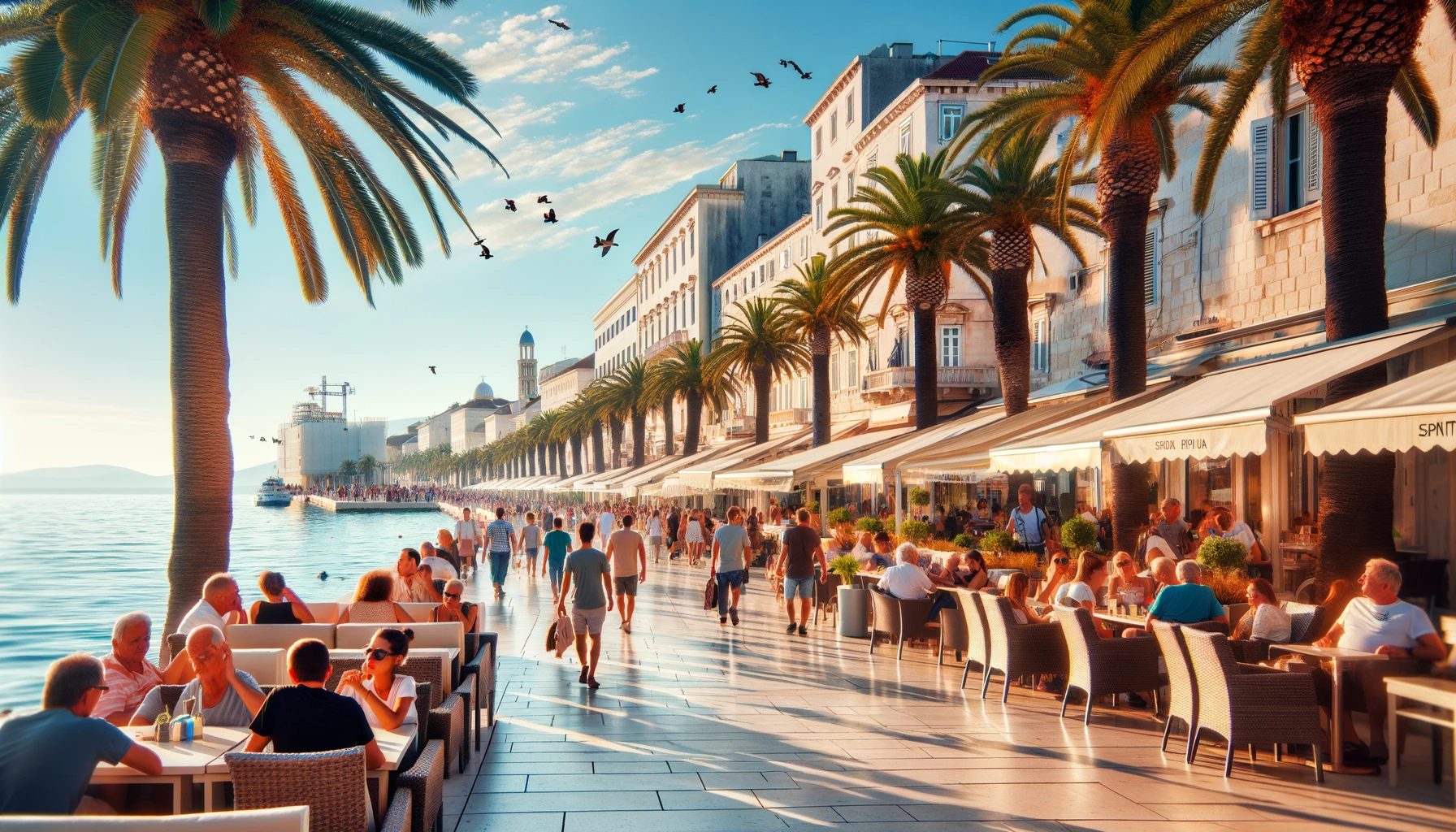
Split, with its blend of historical charm and vibrant modern life, offers an array of activities to suit every interest. Here are some of the best things to do in this stunning city:
- Explore Diocletian’s Palace: A UNESCO World Heritage site, this ancient palace is the heart of Split. Wander through its labyrinthine streets, discover hidden courtyards, and soak in the history.
- Stroll Along the Riva: Split’s seafront promenade, the Riva, is perfect for a leisurely walk, brimming with cafes and offering picturesque views of the harbor.
- Climb Marjan Hill: For the best panoramic views of the city and the sea, a hike up Marjan Hill is a must. It’s a peaceful retreat with shaded paths and ancient chapels.
- Relax on Bačvice Beach: Enjoy the sun and sea at Bačvice Beach, a favorite spot for both locals and tourists to swim and play ‘picigin’, a traditional Croatian ball game.
- Visit the Split City Museum: Dive into the history of Split at the City Museum, housed in a beautiful Gothic palace.
- Sample Local Cuisine: Croatian cuisine is a must-try, especially the fresh seafood and local wines. Visit a traditional ‘konoba’ for an authentic dining experience.
- Day Trips to Nearby Islands: Take a ferry to explore nearby islands such as Hvar, Brač, or Vis, each offering its unique charm and beauty.
- Day Trip To Plitvice Waterfalls: Full day trip enjoying some of the most astounding waterfalls in Europe.
- Trip To Krka Waterfalls and Wine Tasting Tour: We went for the wine, but seeing the Krka waterfalls is equally enchanting (almost)!
- Enjoy the Nightlife: Experience Split’s nightlife, from relaxed bars to lively clubs. The city has a vibrant scene to suit all moods.
- Attend a Festival or Event: Depending on the time of year, attend local festivals or cultural events that showcase music, art, and cuisine.
- Shop at the Green Market (Pazar): Immerse yourself in local life at Split’s bustling outdoor market, where you can find everything from fresh produce to handmade souvenirs.
Whether you’re a history buff, a nature lover, a foodie, or just looking to relax and soak up the Mediterranean vibe, Split offers a rich and varied experience. Now, let’s delve into the culinary journey that awaits you in this Adriatic gem.
Food and Culinary Scene in Split
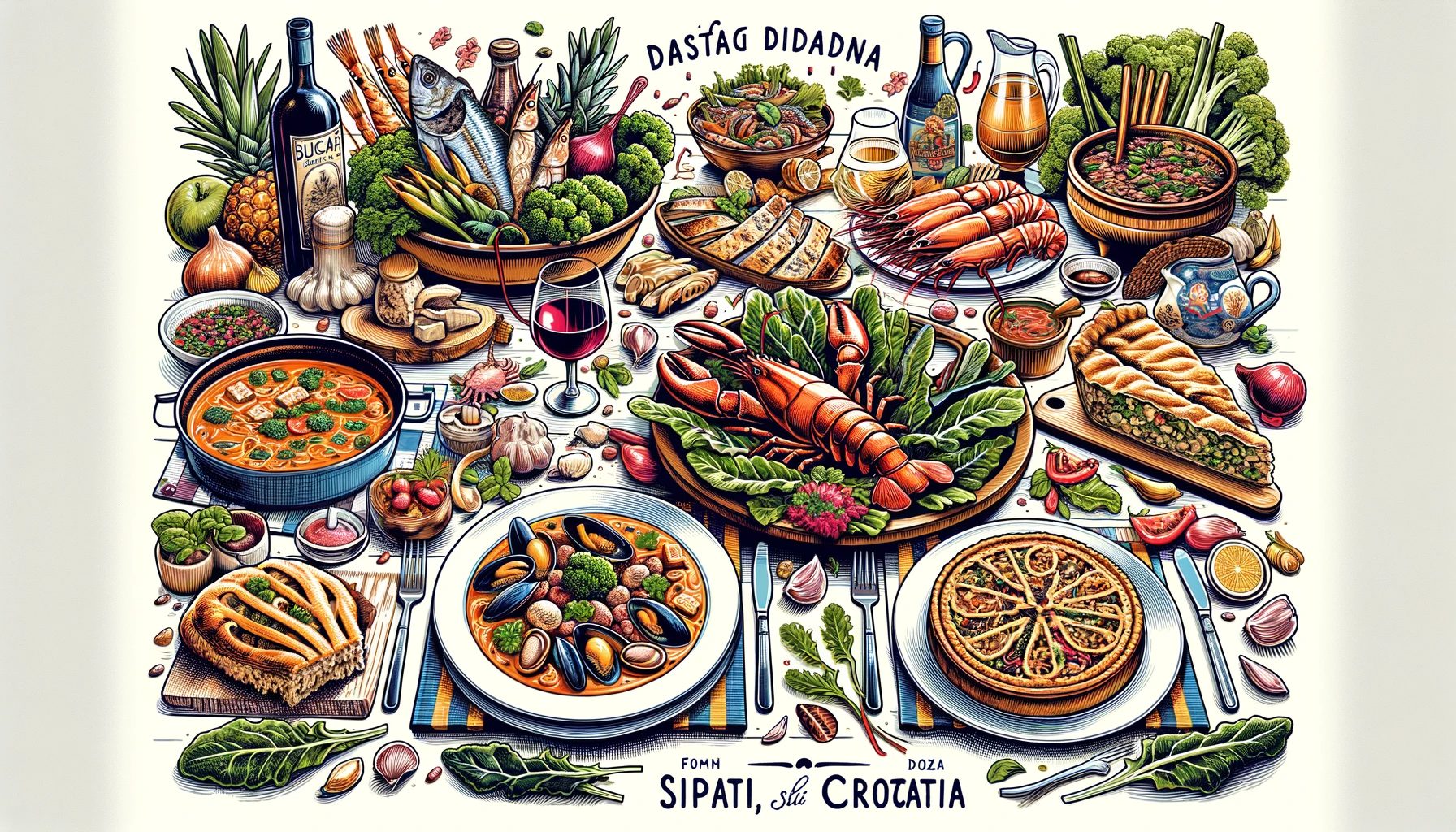
Split’s culinary scene is a delightful blend of Mediterranean flavors and Croatian tradition. The city’s coastal location ensures a bounty of fresh seafood, a staple in local dishes.
Don’t miss trying ‘risto’ (Adriatic squid) and ‘brudet’ (fish stew). The bustling Green Market (Pazar) is a treasure trove of fresh, local produce, ideal for those who love exploring vibrant food markets. For a taste of local life, visit a traditional ‘konoba’ (tavern) to savor dishes like ‘pašticada’ (Dalmatian beef stew) and ‘soparnik’ (Swiss chard pie).
Accompanied by excellent local wines, Split’s food scene offers an authentic and delicious culinary adventure.
5 best restaurants in Split
Here are five highly recommended restaurants in Split:
- Villa Spiza: This cozy eatery is a favorite among locals and tourists alike for its authentic Dalmatian dishes. The menu changes daily based on fresh, seasonal ingredients.
- Bokeria Kitchen & Wine Bar: Known for its stylish interior and creative cuisine, Bokeria offers a fusion of traditional and modern dishes, complemented by an excellent selection of wines.
- Konoba Marjan: Here you can enjoy traditional Croatian food in a warm, inviting atmosphere. It’s particularly famous for its seafood dishes, prepared with freshly caught fish and local ingredients.
- Dvor: With a beautiful beachside setting, Dvor combines exquisite views with a menu of Mediterranean and Croatian specialties. It’s an ideal spot for a romantic dinner or a relaxing meal with sea views.
- Zrno Soli: Located in the ACI Marina, this restaurant offers a sophisticated dining experience with a focus on seafood. The elegant ambiance and the views over the marina and Adriatic Sea make it a memorable dining spot.
Each of these restaurants not only serves delicious food but also offers a glimpse into the local culture and lifestyle, making them must-visit destinations for any food enthusiast in Split.
Vegetarian and vegan-friendly options in Split
Drinking Water in Split
The tap water is generally safe to drink. The water supply in Split, as in most of Croatia, undergoes strict quality control procedures to ensure it meets health and safety standards. The tap water is sourced from well-protected natural springs and is regularly tested for purity.
For visitors, this means you can comfortably drink water straight from the tap in homes, hotels, and public places without concern. It’s not only safe but also practical and environmentally friendly, as it reduces the reliance on bottled water.
However, some travelers might find the taste of the local tap water different from what they’re used to. In such cases, bottled mineral water is readily available in supermarkets, convenience stores, and kiosks throughout the city.
Carrying a reusable water bottle can be a good idea, allowing you to refill it as needed while exploring the city. This practice is not only cost-effective but also supports sustainable tourism practices.
Tiping Culture
Here are some tips on tipping:
- Restaurants and Bars: It’s customary to leave a tip in restaurants and bars, especially if you’re satisfied with the service. The usual amount is around 10% of the bill. However, tipping is not mandatory, and the amount can vary based on your experience.
- Cafes and Smaller Eateries: In more casual settings like cafes, it’s common to round up the bill or leave small change.
- Taxis: For taxi services, rounding up to the nearest 10 HRK (Croatian Kuna) or leaving an extra 5-10% of the fare is appreciated.
- Tour Guides and Private Drivers: If you’re taking a guided tour or hiring a private driver, a tip of around 10% of the total cost is a good guideline, especially if you’re happy with the service.
- Hotel Staff: For hotel bellhops and housekeeping, a tip of around 10-20 HRK per service or per day is customary.
Remember, while tipping is appreciated, it’s not obligatory. It’s seen as a gesture of appreciation for good service. Always feel free to adjust the tip based on your level of satisfaction with the service provided.
Networking and Socializing in Split
Split, with its friendly locals and laid-back Mediterranean atmosphere, offers ample opportunities for networking and socializing. The city’s numerous cafes and bars along the Riva and within Diocletian’s Palace are perfect for meeting people in a relaxed setting.
For professionals, coworking spaces like WIP Coworking and Saltwater Workspace provide a platform to connect with fellow digital nomads and local entrepreneurs.
Regular cultural events, festivals, and outdoor markets also serve as great social hubs. Joining local tours or group activities, such as sailing trips or guided city tours, can be another excellent way to meet people and make connections in Split.
Cultural events and festivals in Split
The city hosts a variety of events and festivals throughout the year, celebrating everything from its ancient heritage to contemporary arts. Here are some notable cultural events and festivals in Split:
- Split Summer Festival: This is one of the most significant cultural events, held annually in July and August. It features a series of performances including opera, ballet, theater, and concerts, held in various historic venues around the city.
- Split Film Festival: A celebration of international and independent cinema, this festival held in September showcases a diverse range of films, including experimental and avant-garde works.
- Ultra Europe Music Festival: One of Europe’s most famous electronic music festivals, Ultra Europe takes place in Split every July, drawing top international DJs and huge crowds of music enthusiasts.
- Days of Diocletian: Held in August, this festival turns back time to the Roman era. The city comes alive with people dressed in Roman attire, re-enactments, and various events that pay homage to Split’s ancient past.
- Sudamja – Feast of Saint Domnius: Celebrated in May, this is the city’s patron saint’s feast day. It involves a series of religious ceremonies, processions, concerts, and other cultural events.
- Advent in Split: During the Christmas season, the city transforms into a festive wonderland with its Advent program. It includes a Christmas market, live music, food stalls, and various family-friendly activities.
These events not only offer entertainment but also a deep dive into the local culture and traditions, making them a must-experience for visitors to Split.
Nightlife and entertainment in Split
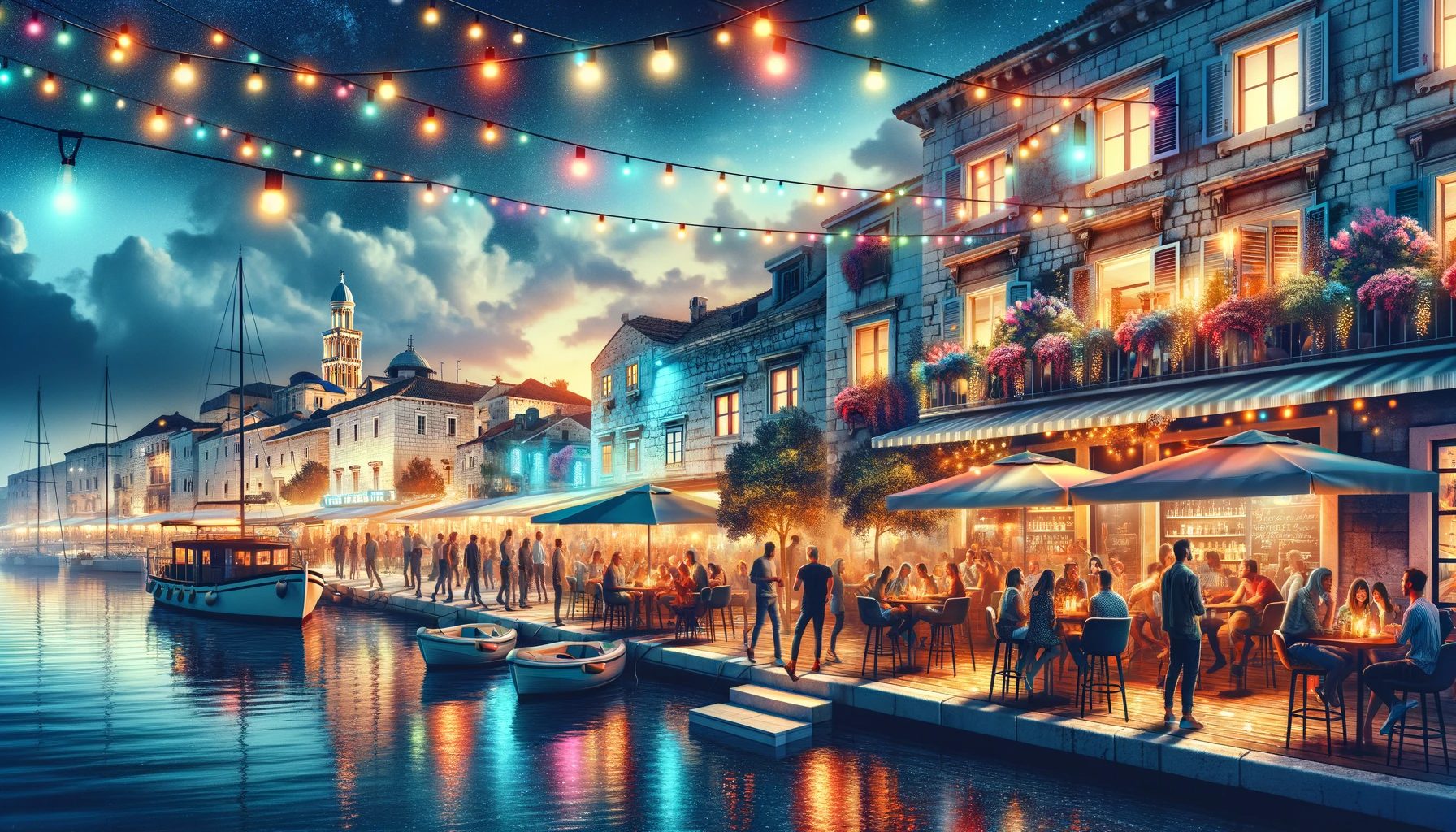
Here’s a glimpse into the city’s nightlife and entertainment scene:
- Bars and Pubs: The Riva and the areas around Diocletian’s Palace are dotted with numerous bars and pubs, perfect for enjoying a relaxing drink. Places like Fabrique Pub and Ghetto Club offer a great ambiance and often live music.
- Clubs and Discos: For those looking to dance the night away, clubs like Vanilla Club and Central Club offer a lively atmosphere with DJs spinning various genres.
- Open-Air Cafes: Enjoy Split’s balmy evenings at one of the many open-air cafes along the waterfront and the Marjan hill, offering stunning views and a relaxed vibe.
- Live Music and Performances: Many bars and venues in Split host live music nights, featuring everything from local bands playing traditional Croatian music to international genres.
- Cultural Events and Theatres: For a more subdued evening, check out the Croatian National Theatre in Split, which hosts various performances including opera, ballet, and drama.
- Beach Clubs: Beach clubs like Znjan Beach and Bacvice Beach Club offer a unique combination of beach relaxation by day and party atmosphere by night.
- Wine Bars: Explore Split’s wine bars to taste local Dalmatian wines. Places like Zinfandel Food & Wine Bar offer a sophisticated atmosphere and a selection of fine wines.
Split’s nightlife truly caters to a wide range of preferences, whether you’re in the mood for a quiet evening or a night of dancing and fun.
Best time to visit Split
The best time to visit Split, Croatia, largely depends on your preferences and the type of experience you’re looking for. Here’s a breakdown of what to expect across different seasons:
- Late Spring (May to June): This period is ideal for those who want to enjoy pleasant weather without the peak summer crowds. The temperatures are warm, perfect for outdoor activities and sightseeing, and the Adriatic Sea starts to warm up for swimming.
- Summer (July to August): This is the peak tourist season. Expect hot, sunny weather, ideal for beach activities and island hopping. The city buzzes with energy, with numerous festivals and events. However, be prepared for larger crowds and higher prices.
- Early Autumn (September to October): Similar to late spring, early autumn offers warm weather and fewer tourists. The sea remains warm enough for swimming, and it’s a great time to explore the city’s cultural offerings and outdoor attractions comfortably.
- Winter (November to February): Winters are mild in Split, with fewer tourists. It’s a good time if you prefer a quieter visit and don’t mind cooler temperatures. While it’s not ideal for beach activities, you can enjoy the city’s indoor attractions, local cuisine, and festive events like Advent in Split.
Overall, late spring and early autumn are often recommended for the best balance of good weather, fewer crowds, and a more authentic experience of the city’s lifestyle.
How To Get To Split
Getting to Split is relatively straightforward, thanks to its well-connected transportation system. Here are the main ways to reach this beautiful Croatian city:
- By Air: The Split Airport (SPU), also known as Resnik Airport, is the closest and most convenient way to fly into the city. It’s located about 20 km west of Split and serves numerous international and domestic flights. From the airport, you can take a bus, taxi, or rent a car to reach the city center.
- By Bus: Split has a well-connected bus network, with frequent services from major cities in Croatia and neighboring countries. The main bus station in Split is centrally located and is a hub for both international and domestic routes.
- By Train: While not the most popular option due to limited routes, there are train services that connect Split with other Croatian cities like Zagreb. The train station in Split is near the city center and the ferry port.
- By Car: Driving to Split offers flexibility and the opportunity to enjoy the scenic Croatian countryside. The city is well-connected by highways, with the A1 being the main route connecting Split to the rest of Croatia.
- By Ferry: Split is a major port with ferry connections to many Adriatic islands like Hvar, Brač, and Korčula, as well as to Italian ports. The ferry terminal is conveniently located close to the city center.
- By Private Boat: For a more luxurious approach, private boat transfers can be arranged from various locations along the Adriatic coast.
Each mode of transportation offers its own experience, with the choice depending on your starting point, budget, and preference. Once in Split, the city’s compact and pedestrian-friendly nature makes it easy to explore.
How to get around Split
Public Transport in Split
Public transport in Split is reliable and efficient, mainly consisting of an extensive bus network that connects the city center with the suburbs and nearby areas. Here are key details about using public transport in Split:
- Bus Service: The city’s bus service is the primary mode of public transport. Operated by Promet Split, the buses cover most areas of the city and its surroundings. The main bus station is located near the Riva, in the city center, making it easily accessible.
- Bus Routes and Timetables: There are numerous bus routes servicing Split, including both local and regional lines. Timetables and route maps are available at bus stations and online on the Promet Split website.
- Tickets: Bus tickets can be purchased from kiosks, at the bus station, or directly from the bus driver. It’s generally cheaper to buy your ticket at a kiosk. Remember to validate your ticket once you board the bus.
- Passes: For longer stays, consider purchasing a daily or weekly pass, which offers unlimited travel and is more cost-effective.
- Night Buses: There are also night bus services, though less frequent, that operate on major routes, useful for late-night travel.
- Reliability and Frequency: Buses are generally reliable and frequent, especially on major routes. However, schedules can be less predictable during weekends and public holidays.
- Other Public Transport Options: While buses are the main public transport, Split also has a network of ferries connecting to nearby islands. These ferries depart from the Split harbor and are a popular mode of transport for both locals and tourists.
Using public transport in Split is a convenient and economical way to explore the city and its beautiful surroundings. For specific routes, schedules, and ticket prices, it’s advisable to check the latest information from Promet Split or local tourist information centers.
Itineraries in Split
Creating itineraries in Split offers a chance to explore the city’s rich history, stunning landscapes, and vibrant culture. Here are a few itinerary ideas to help you make the most of your visit:
1-Day Itinerary: Exploring the Heart of Split
- Morning: Start with a visit to Diocletian’s Palace, a UNESCO World Heritage site. Explore the cellars, peristyle, and Saint Domnius Cathedral.
- Midday: Grab lunch at one of the local konobas (taverns) in the old town.
- Afternoon: Stroll along the Riva Promenade and relax by the sea. Then, visit the Mestrovic Gallery to admire the works of Croatia’s renowned sculptor, Ivan Meštrović.
- Evening: Enjoy dinner at a restaurant along the waterfront, followed by a leisurely walk or a drink at a local bar.
2-Day Itinerary: Split and Surroundings
- Day 1: Follow the 1-day itinerary for exploring Split.
- Day 2: Take a day trip to one of the nearby islands like Brač or Hvar, or visit the ancient ruins of Salona and the medieval fortress of Klis.
3-Day Itinerary: In-depth Exploration
- Day 1 & 2: Follow the 2-day itinerary.
- Day 3: Hike or cycle around Marjan Hill for great views and nature. In the afternoon, explore the local markets and maybe take a cooking class to learn about Dalmatian cuisine.
4-Day Itinerary: Split and National Parks
- Day 1 to 3: Follow the 3-day itinerary.
- Day 4: Take a day trip to Krka National Park or Plitvice Lakes National Park for breathtaking natural scenery and waterfalls.
5-Day Itinerary: The Complete Experience
- Day 1 to 4: Follow the 4-day itinerary.
- Day 5: Spend the day relaxing at one of the nearby beaches like Bačvice or Kasjuni. In the evening, explore the vibrant nightlife or enjoy a farewell dinner at a fine dining restaurant.
For an easier time in Split, book one of these expertly guided tours:
These itineraries can be adjusted based on your interests, whether it’s history, nature, gastronomy, or relaxation. Split’s compact size makes it easy to customize your visit, ensuring a memorable experience.
As always, let’s answer a bunch of questions some nomad friends asked us about Split.
What are some recommended day trips from Split?
Some popular day trip options from Split include visiting the stunning Plitvice Lakes National Park, exploring the historic city of Dubrovnik, or taking a boat tour to the nearby islands of Hvar or Brac. Here are some expert trips you can book right away:
How is the digital nomad community in Split, Croatia?
Split has a thriving digital nomad community, offering opportunities for networking, socializing, and knowledge sharing among individuals who embrace the nomadic lifestyle.
Is it easy to work remotely in Split?
Yes, Split provides a conducive environment for remote work, with numerous cafes, restaurants, and coworking spaces offering reliable internet connectivity and a supportive infrastructure for digital nomads.
Can digital nomads obtain a visa to live and work in Croatia?
Croatia offers a digital nomad visa, allowing eligible individuals to reside and work in the country for an extended period, making it an attractive option for those seeking a temporary base for their nomadic lifestyle.
What advice would you give to someone considering the nomad lifestyle in Split, Croatia?
Embrace the nomad lifestyle in Split by immersing yourself in the local culture, exploring the city’s hidden gems, connecting with the digital nomad community, and finding a balance between work and leisure to make the most of your experience in this vibrant Croatian city.
Split, Croatia as a digital nomad destination – Yes or No?
Split, with its unique blend of ancient history, stunning natural beauty, and modern amenities, has emerged as a captivating destination for digital nomads and travelers alike. The city’s rich cultural heritage is anchored by the impressive Diocletian’s Palace, a UNESCO World Heritage site, offering a work environment surrounded by history.
For digital nomads, the reliable high-speed internet, an array of cozy cafes, and a growing number of coworking spaces provide the perfect setup for remote work. Split’s Mediterranean climate, with its sunny days and mild winters, makes it an ideal year-round destination.
The cost of living is relatively affordable compared to other European cities, adding to its appeal. The local cuisine, vibrant nightlife, and proximity to idyllic islands offer a balanced lifestyle between work and leisure. All these factors, combined with the warm hospitality of its people, make Split a top choice for those seeking a dynamic yet relaxed way of life.
If you’re headed south to Dubrovnik, check our digital nomad guide to Dubrovnik.
Are you traveling to Zagreb? Here’s our guide on the best things to do in the capital of Croatia.
Check out the rest of the balkan nomad guides:
- Digital Nomad Guide To Croatia
- Digital Nomad Guide To Podgorica, Montenegro
- Digital Nomad Guide To Sofia, Bulgaria
- Digital Nomad Guide To Slovenia
- Digital Nomad Guide To Thessaloniki

Avid travelers, passionate fishermen, and all-around great guys to hang out with (therefore the reason why they are the ones traveling around and not the rest of us, introverts and repulsive individuals). When not writing about their latest trip or catch, they drink beer, play the synth and call their friends to unpurposefully annoy them. A lot.